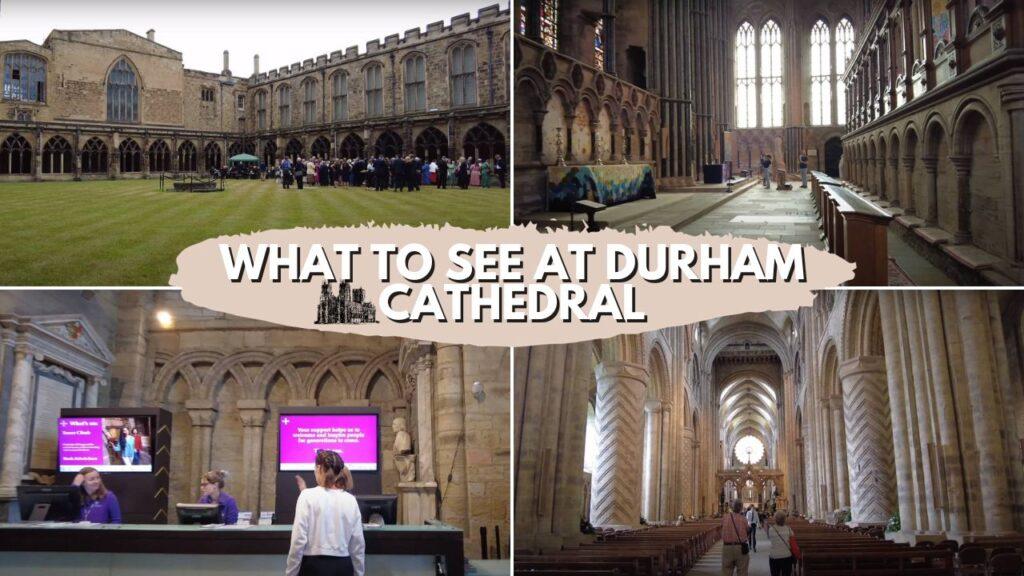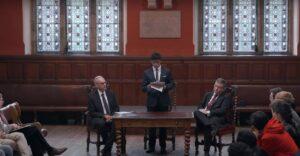If you love Harry Potter, you should visit Durham Cathedral, where some of the scenes from the first two films were shot. You can see the cloister, where Harry walked with his owl Hedwig, and where Ron vomited a slug. You can also see the Chapter House, where Professor McGonagall taught the students to turn animals into water goblets. Climb the tower, where you can enjoy a panoramic view of the city and the countryside.
This article will help you prepare for your visit to Durham Cathedral and enjoy your time there. We will cover the following topics: Best time to visit, Opening hours and tickets, How to get there, what to see, special events and festivals.
About Durham Cathedral
Durham Cathedral is a masterpiece of Romanesque architecture, built in the 11th and 12th centuries to house the relics of St Cuthbert and the Venerable Bede. It is also the seat of the Bishop of Durham, the fourth-ranking bishop in the Church of England hierarchy. The cathedral has a rich and fascinating history, having witnessed the Norman Conquest, the Scottish invasions, the Reformation, the Civil War, and the Industrial Revolution.
It has also been featured in several films and TV shows, such as Harry Potter, Elizabeth, and The Crown. Durham Cathedral is a UNESCO World Heritage Site, along with the adjacent Durham Castle, which was once the residence of the powerful Prince-Bishops of Durham. Together, they form one of the most stunning and historic sites in the UK.
Best Time to Visit Durham Cathedral
The best time to visit Durham Cathedral depends on several factors, such as weather, seasons, holidays, and special events. Each month or season has its advantages and disadvantages, depending on your preferences and expectations. Here are some of the pros and cons of visiting in different months(January – December) or seasons in table format:
| Month | Weather | Crowds | Prices | Events |
|---|---|---|---|---|
| January | Quiet and cold, dark and dreary, shorter days and less sunlight | Fewer tourists | Lower prices | No major events or festivals, possible reduced opening hours or closures due to maintenance or refurbishment |
| February | Quiet and cold, possible snow or frost, making the cathedral look more beautiful and magical | Fewer tourists | Lower prices | Some events related to Valentine’s Day or half-term holidays, such as concerts or workshops |
| March | Transitional, spring approaching and daylight increasing, unpredictable weather, rain or sunshine | Busier with visitors, especially during Easter weekend or Mother’s Day | Moderate prices | Some events related to Lent or Easter, such as services or exhibitions |
| April | Pleasant, warmer weather and more flowers blooming | Very busy with visitors, especially during Easter weekend or school holidays | Higher prices | Some events related to Easter or St George’s Day, such as processions or performances |
| May | Lovely, sunny weather and green scenery | Moderately busy with visitors, especially during bank holidays or weekends | Moderate prices | Some events related to May Day or Spring Bank Holiday, such as fairs or markets |
| June | Beautiful, long days and clear skies | Quite busy with visitors, especially during summer holidays or weekends | Higher prices | Some events related to Midsummer or Summer Solstice, such as concerts or celebrations |
| July | Hot, high temperatures and humidity | Very busy with visitors, especially during summer holidays or weekends | Higher prices | Some events related to the Durham Miners’ Gala or Durham Brass Festival, such as parades or music shows |
| August | Hot, similar to July | Very busy with visitors, especially during summer holidays or weekends | Higher prices | Some events related to the Durham Regatta or Durham Book Festival, such as races or readings |
| September | Mild, cooler weather and autumn colors | Moderately busy with visitors, especially during Heritage Open Days or weekends | Moderate prices | Some events related to Harvest Festival or Durham Lumiere, such as services or light installations |
| October | Cool, crisp weather and falling leaves | Quiet with visitors, especially during weekdays or evenings | Lower prices | Some events related to Halloween or half-term holidays, such as tours or workshops |
| November | Cold, frosty weather and nights | Quiet with visitors, especially during weekdays or evenings | Lower prices | Some events related to Remembrance Day or Advent, such as services or markets |
| December | Festive, snowy weather and Christmas lights | Busy with visitors, especially during the Christmas holidays or weekends | Higher prices | Some events related to Christmas Eve, Christmas Day, Boxing Day, or New Year’s Eve, such as carols, nativity scenes, or fireworks |
Opening Hours: Durham Cathedral
Durham Cathedral is open to visitors every day of the year except on Christmas Day and Good Friday. The general opening hours of the cathedral are as follows:
- Monday to Saturday: 9:30 am to 6 pm (last entry at 5:30 pm)
- Sunday: 12:30 pm to 5:30 pm (last entry at 5 pm)
How to get to Durham Cathedral
Durham Cathedral is located in the city of Durham, in County Durham, England. You can get to Durham by train, bus, car, or bike.
Durham is well connected by train to major cities such as London, Edinburgh, Newcastle, York, Leeds, Manchester, and Birmingham. The journey time from London is about 3 hours, from Edinburgh is about 2 hours, and from Newcastle is about 15 minutes. The train station is about 15 minutes walk from the cathedral. You can also take a taxi or a bus from the station to the cathedral.
Several bus services stop near the cathedral, such as Arriva North East (6/6A), Go North East (X12/X21/X22), Scarlet Band (204), Stanley Travel (208), or Weardale Motor Services (101/764). You can check Traveline for timetables and fares.
Durham is easily accessible by car from major roads such as A1(M), A19, A66, A68, or A690. You can use Google Maps or AA Route Planner. There are several car parks near the cathedral, such as Prince Bishops Shopping Centre Car Park, The Gates Shopping Centre Car Park, and Walkergate Car Park.
Durham is a bike-friendly city, with many cycle paths and routes. You can use [CycleStreets] or [OpenCycleMap] for maps and guidance. You can also hire a bike from [Bike Hire Direct] or [Durham Bike Hire]. There are bike racks near the cathedral, such as at the Palace Green Library or on Saddler Street.
What to See at Durham Cathedral
Durham Cathedral has many attractions that you can see during your visit. Here are some of them:

- The Nave: The nave is the main body of the cathedral, where you can admire the magnificent architecture and art. You can see the vaulted ceiling, the pillars, the arches, the windows, and the sculptures. You can also see the font, the lectern, the pulpit, and the altar. You can also sit on a pew and enjoy the atmosphere and acoustics.
- The Transepts: The transepts are the two arms of the cathedral that cross the nave at right angles. They contain several chapels dedicated to different saints and themes.
- The Chapel of Nine Altars: This chapel is located at the east end of the cathedral, behind the high altar. It was built in the 13th century to accommodate the increasing number of pilgrims who came to venerate the relics of St Cuthbert. It has nine altars along the walls, each with a different dedication and decoration. You can also see some stained glass windows, some medieval paintings, and some modern sculptures.
- The Chapel of St Cuthbert: This chapel is located at the east end of the south transept, next to the Shrine of St Cuthbert. It was built in the 12th century to house the tomb of St Cuthbert, the patron saint of Durham and Northumbria. St Cuthbert was a monk, a bishop, and a miracle worker, who died in 687 AD. His body was moved several times due to Viking raids and political turmoil until it was finally settled in Durham in 995 AD. His tomb is covered by a marble slab, which has an inscription and a cross. You can also see some relics of St Cuthbert, such as his pectoral cross, his portable altar, and his coffin.
- The Tower: The tower is the highest point of the cathedral, offering spectacular views of the city and the surrounding countryside. You can climb up 325 steps to reach the top of the tower. The tower is open from 10 am to 4 pm (last entry at 3:30 pm) from Monday to Saturday, and from 12:30 pm to 3 pm (last entry at 2:30 pm) on Sunday. The admission fee for the tower is £5 for adults and £2.50 for children.
- The Cloister: The cloister is the covered walkway around the central courtyard of the cathedral. It is famous for its vaulted ceiling and medieval carvings. You can also see some film locations from Harry Potter in the cloister. The cloister is open during the same hours as the cathedral. There is no admission fee for the cloister.
- The Treasury: A museum of holy and valuable items from the cathedral, like relics, manuscripts, and sculptures. The treasury is open from 10 am to 5 pm (last entry at 4:30 pm) from Monday to Saturday, and from 12:30 pm to 5 pm (last entry at 4:30 pm) on Sunday. The admission fee for the treasury is £2.50 for adults and £1 for children.
- The Library: The library is a treasure trove of books and documents that span over a thousand years of history. You can see some rare and ancient manuscripts, such as the Lindisfarne Gospels, the Durham Gospels, and the Venerable Bede’s works. You can also see some exhibitions and events that showcase different aspects of the library’s collection. The library is open from 10 am to 4 pm (last entry at 3:45 pm) from Monday to Friday, and from 12:30 pm to 2:30 pm on Saturday. There is no admission fee for the library.
You can book tickets for the tower and the treasury online or in person at the visitor desk in the cathedral. Buy a combined ticket for both attractions for £6 for adults and £3 for children. You can also buy a souvenir guidebook for £5 or an audio guide for £3 at the visitor desk.
Durham Cathedral is a magnificent and historic site that you should not miss when visiting Durham. It offers a unique and memorable experience for visitors of all ages and backgrounds. Whether you are interested in architecture, history, art, or religion, you will find something to admire and enjoy at Durham Cathedral.
Also, Explore: Places to Visit in England






